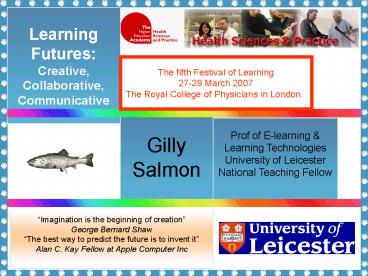Learning Futures: Creative, Collaborative, Communicative - PowerPoint PPT Presentation
1 / 45
Title:
Learning Futures: Creative, Collaborative, Communicative
Description:
'Imagination is the beginning of creation' George Bernard Shaw ' ... www.impala.ac.uk. Web 2.0. Personalisation. Mobility. Open Source. http://ocw.mit.edu/index.html ... – PowerPoint PPT presentation
Number of Views:74
Avg rating:3.0/5.0
Title: Learning Futures: Creative, Collaborative, Communicative
1
Learning Futures Creative, Collaborative,
Communicative
The fifth Festival of Learning 27-29 March 2007
The Royal College of Physicians in London.
Gilly Salmon
Prof of E-learning Learning TechnologiesUniver
sity of LeicesterNational Teaching Fellow
Imagination is the beginning of
creation George Bernard Shaw The best way to
predict the future is to invent it Alan C. Kay
Fellow at Apple Computer Inc
2
15 years of the WWW
- http//news.bbc.co.uk/2/hi/technology/5243862.stm
August 1991
January 2007
3
Why is learning not already transformed?
4
From the Blogosphere
- the most important change agent will be the
emergence by 2010 of a generation of clinicians
who have grown up taking for granted that IT is a
communications and knowledge management medium
rather than a data processing tool. - This generation will have no understanding of
and little tolerance for our ongoing struggles
with the mundane data processing and integration
issues that so dominate our generation's view of
IT our budgets life energies." - (Hunscher 2006 http//www.rodspace.co.uk/blog/200
6/02/health-informatics-20.html)
5
Web 2.0
Personalisation
Mobility
Open Source
6
About Web 2.0
- Web 2.0 technologies and applications
- are characterised by
- a dynamic social element,
- a focus on collaboration
- and sharing
- user contribution
- distinguishes them from
- the traditional Web which transmits
- information mainly one way
7
(No Transcript)
8
Media zoo
- www.le.ac.uk/beyonddistance/mediazoo
9
Second Life
- Second Life is a 3-D virtual world entirely built
and owned by its residents. - Second Life a complete platform for business and
entertainment (not a video game) - Since 2003, it has grown explosively and now is
inhabited by millions of people from around the
globe. - Web 2.0 platform for those interested in the
business, cultural and social potential of online
virtual environments.
10
(No Transcript)
11
(No Transcript)
12
(No Transcript)
13
(No Transcript)
14
(No Transcript)
15
(No Transcript)
16
(No Transcript)
17
(No Transcript)
18
(No Transcript)
19
(No Transcript)
20
(No Transcript)
21
(No Transcript)
22
Web 2.0
Personalisation
Mobility
Open Source
23
- www.le.ac.uk/adelie
24
E-tivities from Inter-Professional Education
Carpe Diem course design workshop by the
Adelie project Beyond Distance Research
Alliance, University of Leicester
25
John and Monicas story One Carers Perspective
Spark for E-tivity 1
- John was 57 years old when he had his stroke,
previously well - John, had moments when he was visually
disorientated Monica now thinks this was
transient ischaemic attacks. - He did not see his GP but the optician prescibed
new glasses. - Introduction (weblink)
- Sky News report (Blackboard content)
26
NEXT Inter-Professional Education E-tivity 2
John's Care Pathway
27
Johns Care Pathway
Spark for E-tivity 2
- Refresh and remind yourself of the resources
available to carers and healthcare professionals
regarding stroke - Stroke guidelines (Royal College of Physicians
concise format pdf) - The Stroke Association (website)
- The National Service Framework for older
people (this is a large PDF file. Refer to
standard 5 which is related to stroke) - Stroke audit abstract (Blackboard content
Abstract of Stroke Audit in 1994) - UHL Stroke guidelines first 48
hours (Blackboard content) - UHL guidelines stroke management
- John's care pathway
- Click here to read John's care pathway (Breeze
presentation)
28
NEXT Inter-Professional Education E-tivity 3
Chocolate or Clinifeed?
29
Chocolate or Clinifeed?
Spark for E-tivity 3
- A complication of John's stroke was the loss of
his swallowing reflex. Therefore, John cannot eat
in the usual way. To address this problem, John
has a PEG (Percutaneous Endoscopic Gastrotomy). - Resources
- About PEGS (weblink)
- Video Nobody told me (Monicas story weblink)
30
NEXT Inter-Professional Education E-tivity 4
Gadgets and Gizmos
31
Web 2.0
Personalisation
Mobility
Open Source
32
"Ubiquitous"
- Something that is
- common place
- taken for granted
- fades into the environment
- takes little conscious effort to use
- Dave Raggett
- WWW200 Conference
- Edinburgh, May 2006
- http//wearables.cs.bris.ac.uk/
33
Everywhere
- Todays devices will disappear. Electronics will
instead be embedded in our environment, woven
into our clothing, and written directly to our
retinas from eyeglasses and contact lenses - Devices will no longer be spokes on the
Internetthey will be the nodes themselves, - Futurist Ray Kurzweil From Red Herring, April 10,
2006
34
- www.impala.ac.uk
35
Web 2.0
Personalisation
Mobility
Open Source
36
http//ocw.mit.edu/index.html
37
(No Transcript)
38
(No Transcript)
39
http//openlearn.open.ac.uk/
40
RSS feeds
- Web 2.0 technology allows website syndication
- A portion of a web site (called a web feed) is
available to a subscriber - Web 1 led to blogs
- Web 2 allows links to other files e.g. mps audio
files
41
(No Transcript)
42
Web 2.0
Personalisation
Mobility
Open Source
43
You dont think any of this will happen?
- ...data processing is a
- fad that won't last out the year." Editor of
business books Prentice Hall, 1957. - Theres no reason for
- any individual to have a computer in their
homes, Ken Olson, Chairman, Digital Corp. 1977 - 640K ought to be enough for anybody." Bill Gates,
1981.
- this telephone has too many shortcomings to be
seriously considered as a means of communication.
Western Union memo 1876 - ...theres a world market for about 5 computers.
Thomas Watson, Chairman IBM 1943. - Computers in the future may weigh no more than
1.5 tons." Popular Mechanics, 1949
44
Resources
- www.e-moderating.com
- www.e-tivities.com
- www.atimod.com
- www.learningingroups.com http//openlearn.open.ac.
uk/ - http//ocw.mit.edu/index.html
- http//tim.oreilly.com/
- http//www.tagzania.com/
- www.learnometer.net/
- www.futurelab.org.uk/
- www.heppell.net/
- http//news.bbc.co.uk/2/hi/technology/5243862.stm
- http//wearables.cs.bris.ac.uk/
- www.e-health-insider.com/news/item.cfm?ID2101
- http//en.wikipedia.org/wiki/Web_2
- http//www.biomedcentral.com/1472-6920/6/41
- Gilly.salmon_at_le.ac.uk
45
(No Transcript)































